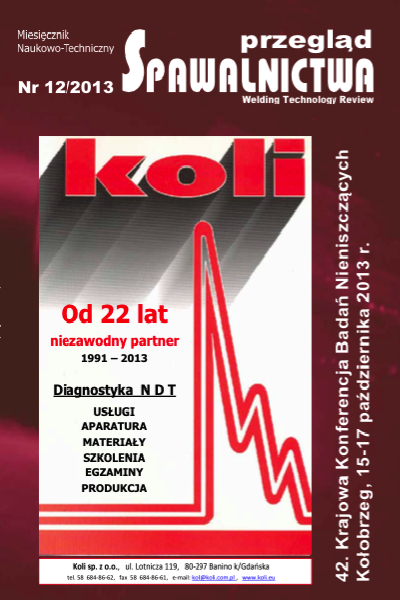Zastosowanie metodologii RBI do doboru metod NDT w diagnostyce urządzeń technicznych podlegających dozorowi UDT
Main Article Content
Abstract
Artykuł dotyczy wykorzystania metodologii RBI (Risk Based Inspection) w ustalaniu aktywności mechanizmów degradacji urządzeń ciśnieniowych i odpowiednim doborze metod NDT w tworzeniu programów inspekcji. Opisano zasady RBI oraz omówiono aspekty utrzymywania integralności mechanicznej urządzeń ciśnieniowych w przemyśle petrochemicznym. Omówiono zależność doboru metod NDT od spodziewanych rodzajów uszkodzeń urządzeń ciśnieniowych wykonanych z metali. Omówiono parametry materiału konstrukcyjnego oraz fizykochemiczne parametry medium procesowego, mające znaczenie w aktywności mechanizmów degradacji urządzeń ciśnieniowych. na przykładzie stali niskostopowej Cr-Mo omówiono przyczyny zagrożenia siarczkowym pękaniem naprężeniowym. Odniesiono się do istotności doboru standardów projektowych oraz do doboru kryteriów akceptacji badań nDT na etapie wytwarzania i eksploatacji z zastosowaniem przewidywania aktywności mechanizmów degradacji przy doborze metod inspekcyjnych. Zaproponowano rozszerzone wymagania dotyczące opracowania badań nDT na etapie eksploatacji.
RBi methodology application in selection of ndt methods in the diagnostics of technical equipment under inspection of office of technical inspection
Abstract
Article relates to the use of the RBI (Risk Based Inspection) methodology in determining of active degradation mechanisms of pressure equipment and the suitable choice of nDT methods in development of the inspection programs. It describes RBI rules and discusses aspects of maintaining the mechanical integrity of the pressure equipment in petrochemical industry. Discusses dependency of NDT methods selection on the expected failure modes of pressure equipment. Discusses the parameters of the material of construction and physico-chemical parameters of the process medium and their impact on the degradation mechanisms activity in pressure equipment. Discussion was carried out on the example of sulfide stress cracking of Cr-Mo low-alloy steel. Article points out the importance of selection of design standards and acceptance criteria during selection of the NDT methods at the production, and later at operational stage, using prediction of degradation mechanisms activity. The article suggests the need for expanded reporting requirements of NDT during operational stage of pressure equipment.
Downloads
Article Details
Creative Commons CC BY 4.0 https://creativecommons.org/licenses/by/4.0/
Welding Technology Review (WTR) articles are published open access under a CC BY licence (Creative Commons Attribution 4.0 International licence). The CC BY licence is the most open licence available and considered the industry 'gold standard' for open access; it is also preferred by many funders. This licence allows readers to copy and redistribute the material in any medium or format, and to alter, transform, or build upon the material, including for commercial use, providing the original author is credited.
References
API RP 571 Damage Mechanisms Affecting Fixed Equipment in the Refining Industry, Second Edition (April 2011).
API RP 581 Risk-Based Inspection Technology, Second Edi- tion (September 2008).
API RP 580 Risk-Based Inspection; Base Resource Document, First Edition (May 2000).
